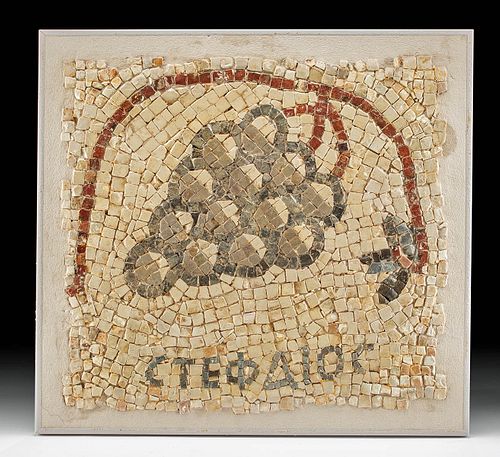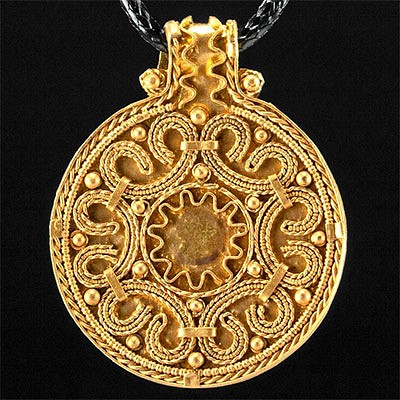Roman Mosaic w/ Grape Bunch on Vine
Lot 45
About Seller
Artemis Fine Arts
686 S Taylor Ave, Ste 106
Louisville, CO 80027
United States
Selling antiquities, ancient and ethnographic art online since 1993, Artemis Gallery specializes in Classical Antiquities (Egyptian, Greek, Roman, Near Eastern), Asian, Pre-Columbian, African / Tribal / Oceanographic art. Our extensive inventory includes pottery, stone, metal, wood, glass and textil...Read more
Estimate:
$3,000 - $4,500
Absentee vs Live bid
Two ways to bid:
- Leave a max absentee bid and the platform will bid on your behalf up to your maximum bid during the live auction.
- Bid live during the auction and your bids will be submitted real-time to the auctioneer.
Bid Increments
| Price | Bid Increment |
|---|---|
| $0 | $25 |
| $300 | $50 |
| $1,000 | $100 |
| $2,000 | $250 |
| $5,000 | $500 |
| $10,000 | $1,000 |
| $20,000 | $2,500 |
| $50,000 | $5,000 |
| $100,000 | $10,000 |
| $200,000 | $20,000 |
About Auction
By Artemis Fine Arts
Aug 19, 2021
Set Reminder
2021-08-19 10:00:00
2021-08-19 10:00:00
America/New_York
Bidsquare
Bidsquare : Ancient & Ethnographic Art Through The Ages
https://www.bidsquare.com/auctions/artemis-gallery/ancient-ethnographic-art-through-the-ages-7345
Ancient art from Egypt, Greece, Italy and the Near East, as well as Asian, Fossils, Pre-Columbian, Native American, African / Tribal / Oceanic, Fine art, and much more! All categories, all price ranges... all legally acquired and guaranteed to be as described or your money back. Artemis Fine Arts info@artemisfinearts.com
Ancient art from Egypt, Greece, Italy and the Near East, as well as Asian, Fossils, Pre-Columbian, Native American, African / Tribal / Oceanic, Fine art, and much more! All categories, all price ranges... all legally acquired and guaranteed to be as described or your money back. Artemis Fine Arts info@artemisfinearts.com
- Lot Description
Roman, Imperial Period, ca. 1st to 3rd century CE. An exceptional mosaic depicting a lush bunch of 13 grapes on a slender vine above an inscribed word, all made from hand-cut stone tesserae in vibrant hues of violet, russet, green, gray, beige, and cream. The sinuous vine arches above the grapes, which are arranged in a triangular form, and then terminates in a small gathering of petite leaves. Written in a combination of the Latin and Greek alphabets, the inscription translates to "Stephaios," a variation of Stephanos meaning "wreath," "garland," or "crown" - the type awarded after an athletic victory and commonly used as a name. This may allude to either the owner of the mosaic or the use of grapes and grapevines in wreaths and garlands. Size (of mosaic): 17.5" W x 16.125" H (44.4 cm x 41 cm); Size (of frame): 19.75" W x 18.5" H (50.2 cm x 47 cm)
Mosaics (opus tesellatum) are some of our enduring images from the Roman world, not only for their aesthetic beauty, but also because they reveal what Romans chose to depict and see every day decorating their private and public spaces. This piece at first glance seems quite simple - a basket of grapes, but the symbolism of the iconography is layered and rich. Perhaps this piece was designed for a dining area, where friends and family together partook in the Bacchian joy of drink or where one hosted a lavish Bacchanalia. As wine was considered a daily necessity shared by all Romans, from slaves to aristocrats, this mosaic would have been relatable to all who saw it and perhaps represented livelihood. While impossible to know for certain, one can muse on these possibilities and certainly appreciate the immense skill and technique it took to create.
The ancient Romans were the first civilization to cultivate grape vines. Grapes and wine of course were associated with Bacchus (identified in ancient Greece as Dionysos or Dionysus) - the Olympian god of wine, pleasure, ritual madness, ecstasy, and theatre who was sometimes depicted as a bearded adult but alternatively depicted as a youth, with a smooth face. The cult of Bacchus was hugely popular, signifying the freedom created by wine, music, and ecstatic dance. Romans knew the power of partying!
Provenance: ex-Phoenicia Holyland Antiquities, New York, New York, USA, acquired before 2010
All items legal to buy/sell under U.S. Statute covering cultural patrimony Code 2600, CHAPTER 14, and are guaranteed to be as described or your money back.
A Certificate of Authenticity will accompany all winning bids.
PLEASE NOTE: Due to recent increases of shipments being seized by Australian & German customs (even for items with pre-UNESCO provenance), we will no longer ship most antiquities and ancient Chinese art to Australia & Germany. For categories of items that are acceptable to ship to Australia or Germany, please contact us directly or work with your local customs brokerage firm.
Display stands not described as included/custom in the item description are for photography purposes only and will not be included with the item upon shipping.
#166419Mounted on a concrete backing. A few small losses and chips to tesserae. Otherwise, in beautiful condition with great preservation of imagery.Condition
- Shipping Info
-
All shipping is handled in-house for your convenience. Your invoice from Artemis Gallery will include shipping calculation instructions. If in doubt, please inquire BEFORE bidding for estimated shipping costs for individual items.
-
- Buyer's Premium



 EUR
EUR CAD
CAD AUD
AUD GBP
GBP MXN
MXN HKD
HKD CNY
CNY MYR
MYR SEK
SEK SGD
SGD CHF
CHF THB
THB














